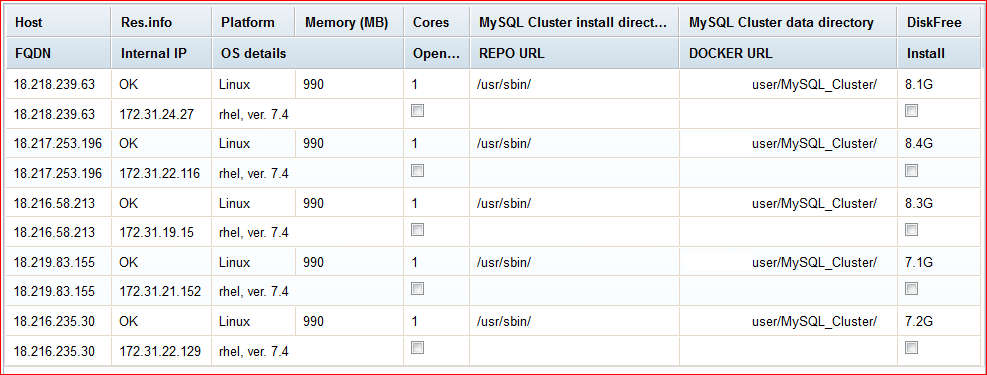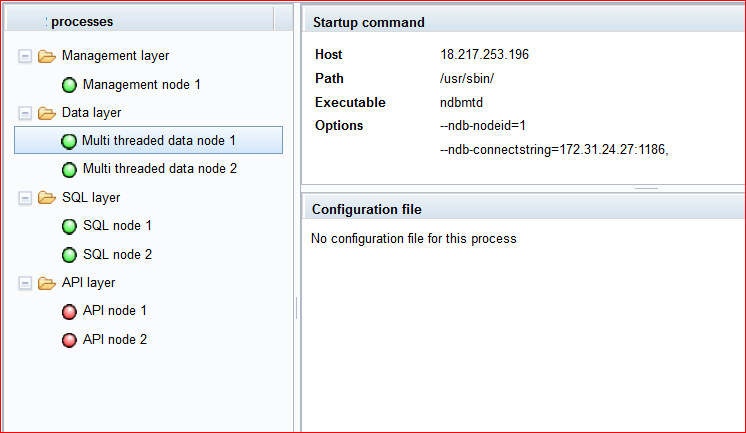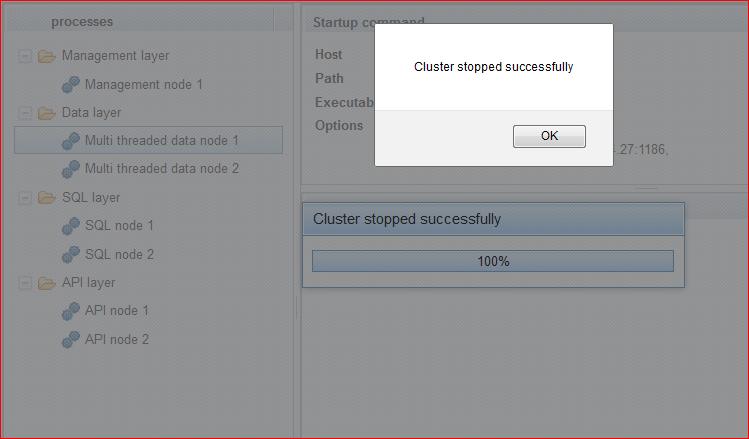In this series of blogs I will do my best to demonstrate how to set up and run Cluster in Cloud environment by hand and by utilizing
MCC. For detailed configuration, I will use
MCC (Auto-installer). Some of the information regarding this setup is provided in
post by Mikael. Information regarding Auto-installer is available in our documentation, HTML help files in share/MCC distribution directory and in
my blog post.
Cloud setup
It might come as surprise but for initial testing any instance should do. I started with 1CPU/1GB RAM ones. The target topology was:
- Host #1: Management node and Cluster client tools.
- Host #2: Multi-threaded DATA node.
- Host #3: Multi-threaded DATA node.
- Host #4: SQL node (MySQL server)/API node.
- Host #5: SQL node (MySQL server)/API node.
 Cloud instances:
Cloud instances:
At your provider of choice, set up topology as described. Most of the providers prefer using keys so set the security and save the key to your local box. After that, set the firewall rules. Here is the list of ports with explanation for this example:
- Port#1186: Port used by management node for communication. It is also used by MCC to connect to Management node host and gather status from/shut down the Cluster. Open it on host #1.
- Port#11860: "ServerPort" used by DATA nodes to communicate with each other. Open it on hosts 2 and 3.
- Port#3306: Standard MySQL server port. You need to open it on hosts 4 and 5.
To open ports via script, please check
Mikael's post.
GOTCHA: Port 3306 on hosts 4 and 5 could already be taken by existing MySQL server installation which you might remove first or change this port to, say, 3316.
$ sudo netstat -tulpn | grep LISTEN
tcp 0 0 0.0.0.0:22 0.0.0.0:* LISTEN 929/sshd
tcp 0 0 127.0.0.1:25 0.0.0.0:* LISTEN 894/master
tcp6 0 0 :::3306 :::* LISTEN 983/mysqld
tcp6 0 0 :::22 :::* LISTEN 929/sshd
tcp6 0 0 ::1:25 :::* LISTEN 894/master
$ sudo /sbin/service mysqld stop
Redirecting to /bin/systemctl stop mysqld.service
$ sudo netstat -tulpn | grep LISTEN
tcp 0 0 0.0.0.0:22 0.0.0.0:* LISTEN 929/sshd
tcp 0 0 127.0.0.1:25 0.0.0.0:* LISTEN 894/master
tcp6 0 0 :::22 :::* LISTEN 929/sshd
tcp6 0 0 ::1:25 :::* LISTEN 894/master
GOTCHA: Usually, MySQL Cluster DATA node will look for available port and auto-assign
ServerPort. However, it is most likely that your Cloud firewall will block everything but specific ports so this value is needed.
If you have localhost deployment or you have two or more DATA nodes on same host, do not assign this value.
After dealing with security and choosing your preferred OS, make note of both public and private IP addresses. Public one we will use to control the processes from
MCC while private ones will be used by processes for inter-communication bypassing DNS service:
 NOTE:
NOTE: The "Open..." refers to "OpenFirewall" field of Host configuration.
Preparing the host(s)
If you're using
MCC, you can configure all the processes and options and create directories/deploy configurations by clicking DEPLOY button on last page.
If you want to do things by hand, please, in your HOME, prepare the directories:
mkdir ndb (or MySQL_Cluster)
cd ndb
mkdir data
cd ..
Place the config.ini file in MGMT node(s) DATADIR you just created (~/ndb/data), place my.cnf in DATADIR on hosts 4 and 5. I will talk of config.ini more later.
Prepare the utilities:
sudo yum update
sudo yum install curl wget unzip zip
Get the RPM and extract:
wget https://dev.mysql.com/get/mysql57-community-release-el7-11.noarch.rpm
sudo rpm -ivh mysql57-community-release-el7-11.noarch.rpm
Check things:
rpm -qa | grep mysql mysql57-community-release-el7-11.noarch
The default values in MySQL repository file enable MySQL server but we need Cluster so change "enabled" value using your favorite editor:
cat /etc/yum.repos.d/mysql-community.repo
[mysql57-community]
name=MySQL 5.7 Community Server
baseurl=http://repo.mysql.com/yum/mysql-5.7-community/el/7/$basearch/
enabled=1 <<<<< 0
gpgcheck=1
gpgkey=file:///etc/pki/rpm-gpg/RPM-GPG-KEY-mysql
[mysql-cluster-7.6-community]
name=MySQL Cluster 7.6 Community
baseurl=http://repo.mysql.com/yum/mysql-cluster-7.6-community/el/7/$basearch/
enabled=0 <<<<< 1
gpgcheck=1
gpgkey=file:///etc/pki/rpm-gpg/RPM-GPG-KEY-mysql
or by issuing:
sudo yum-config-manager --disable mysql57-community
sudo yum-config-manager --enable mysql-cluster-7.6-community
Make sure everything checks out:
cat /etc/yum.repos.d/mysql-community.repo
[mysql-connectors-community]
...
[mysql57-community]
name=MySQL 5.7 Community Server
baseurl=http://repo.mysql.com/yum/mysql-5.7-community/el/7/$basearch/
enabled=0
gpgcheck=1
gpgkey=file:///etc/pki/rpm-gpg/RPM-GPG-KEY-mysql
...
[mysql-cluster-7.6-community]
name=MySQL Cluster 7.6 Community
baseurl=http://repo.mysql.com/yum/mysql-cluster-7.6-community/el/7/$basearch/
enabled=1
gpgcheck=1
gpgkey=file:///etc/pki/rpm-gpg/RPM-GPG-KEY-mysql
Installing Host#1 for the NDB management server is now easy:
sudo yum install mysql-cluster-community-management-server
To properly stop MySQL Cluster or to play with it from
MCC, you will need
ndb_mgm client so you can poll for status and execute various commands:
sudo rpm -ivh http://dl.fedoraproject.org/pub/epel/7/x86_64/Packages/e/epel-release-7-11.noarch.rpm
sudo yum install mysql-cluster-community-client
ndb_mgm --ndb-connectstring=172.31.24.27:1186
ndb_mgm> show
Cluster Configuration
---------------------
[ndbd(NDB)] 2 node(s)
id=1 (not connected, accepting connect from 172.31.22.116)
id=2 (not connected, accepting connect from 172.31.19.15)
[ndb_mgmd(MGM)] 1 node(s)
id=49 @172.31.24.27 (mysql-5.7.18 ndb-7.6.3)
...
Note: Perl is needed to install MySQL Cluster community package. To install Perl we need access to the EPEL packages.
Installing the NDB data nodes on Host#2 and #3 is also very easy:
sudo yum install mysql-cluster-community-data-node
MySQL Cluster server package depends on Perl which is not part of a standard Red Hat installation. So on the Host#4 and #5 used for MySQL Server we first need to install support for Perl by installing EPEL packages (Extra Packages for Enterprise Linux) much like we did for MGMT node host (#1). This is performed through the command:
sudo rpm -ivh http://dl.fedoraproject.org/pub/epel/7/x86_64/Packages/e/epel-release-7-11.noarch.rpm
You might need to check which package actually exists.
After installing this, it is straightforward to install the MySQL Server package. This package will also download the MySQL client package that contains the NDB management client package:
sudo yum install mysql-cluster-community-server
Running the Cluster
You can run Cluster by hand or let the
MCC deal with it. In any case, the start sequence is MGMT node(s), DATA node(s), SQL node(s) and API node(s). When running by hand, sequence of commands by host are like this:
ndb_mgmd -f /home/user/ndb/config.ini --initial --configdir=/home/user/ndb/data --ndb-nodeid=49
There are many ways in which you can mix parameters, for example:
ndb_mgmd --configdir=/home/user/ndb/data/ --config-file=/home/user/ndb/data/49/config.ini
and so on, depending on where DATADIR and config.ini are placed.
Use
ndb_mgm client to confirm node is up as described above.
Then start DATA nodes on hosts 2 and 3:
ndbmtd --connect-string="nodeid=1;172.31.24.27" (Host#2)
ndbmtd --connect-string="nodeid=2;172.31.24.27" (Host#3)
Notice how DATA nodes refer to MGMT node internal IP address and represent themselves with node ID found in config.ini file. It is possible to use external IP too but internal one does not depend on DNS service.
Use
ndb_mgm client to confirm nodes are up as described above.
Next we bootstrap MySQL server and start it:
mysqld --defaults-file=/home/user/ndb/data/my.cnf --initialize-insecure
mysqld --defaults-file=/home/user/ndb/data/my.cnf --ndb-connectstring=172.31.24.27
Since we are preparing test setup, doing this as root is acceptable. However, you will need a lot of SUDO's later.
GOTCHA: Normally, you would never never leave your MySQL setup unprotected! Please observe procedures noted in our
manual and secure your installation:
- Initialize the data directory by invoking mysqld with the
--initialize to let server generate a random initial password for the root@localhost account.
- On *nix systems, it is important to make sure that the database directories and files are owned by the
mysql account so that the server has read and write access to them. To ensure this, start mysqld from the system root account and include the --user option like this:
$ bin/mysqld --initialize --user=mysql
- To add
mysql user/group please use following commands (or addgroup, adduser depending on the Linux flavor):
$ groupadd mysql
$ useradd -r -g mysql -s /bin/false mysql
Because the user is required only for ownership purposes, not login purposes, the useradd command uses the -r and -s /bin/false options to create a user that does not have login permissions to your server host. Omit these options if your useradd does not support them.
Use
ndb_mgm or
MCC to confirm Cluster is up and running:
 GOTCHA:
GOTCHA: By default,
MCC will set
SharedGlobalMemory to 384MB which is too much for microinstance so DATA nodes might not start. Lower this value to 128MB or 256MB, whichever works for you. You can also change
LockPagesInMainMemory=0 to
LockPagesInMainMemory=1 to make this problem more visible.
config.ini: Assuming you let
MCC create configuration and directories for you, ~/ndb/data becomes ~/MySQL_Cluster/NodeID
#
# Configuration file for ...
#
[NDB_MGMD DEFAULT]
ArbitrationRank=1
HeartbeatIntervalMgmdMgmd=1500
Portnumber=1186
[NDB_MGMD]
NodeId=49
HostName=172.31.24.27
DataDir=/home/user/MySQL_Cluster/49/
Portnumber=1186
[TCP DEFAULT]
SendBufferMemory=2M
ReceiveBufferMemory=2M
[NDBD DEFAULT]
NoOfReplicas=1
ServerPort=11860
CompressedLCP=false
LogLevelStartup=1
EventLogBufferSize=8K
DataMemory=4M
IndexMemory=2M
MinFreePct=5
MaxNoOfAttributes=1000
MaxNoOfTables=128
MaxNoOfOrderedIndexes=128
MaxNoOfTriggers=768
MaxNoOfConcurrentSubOperations=256
StringMemory=25
MaxAllocate=32M
Diskless=false
LockPagesInMainMemory=1
ODirect=false
Arbitration=Default
DiskPageBufferEntries=10
DiskPageBufferMemory=128M
MaxNoOfConcurrentTransactions=4096
MaxNoOfConcurrentOperations=131072
MaxNoOfConcurrentScans=256
FragmentLogFileSize=64M
NoOfFragmentLogFiles=4
InitFragmentLogFiles=SPARSE
RedoBuffer=32M
RedoOverCommitCounter=3
RedoOverCommitLimit=20
MaxNoOfExecutionThreads=2
StopOnError=0
CrashOnCorruptedTuple=true
StartFailRetryDelay=0
MaxStartFailRetries=3
[NDBD]
NodeId=1
HostName=172.31.22.116
DataDir=/home/user/MySQL_Cluster/1/
[NDBD]
NodeId=2
HostName=172.31.19.15
DataDir=/home/user/MySQL_Cluster/2/
[MYSQLD DEFAULT]
AutoReconnect=false
BatchByteSize=16K
BatchSize=256
MaxScanBatchSize=256K
[MYSQLD]
NodeId=53
HostName=172.31.21.152
[MYSQLD]
NodeId=54
HostName=172.31.22.129
[API]
NodeId=231
HostName=172.31.21.152
[API]
NodeId=232
HostName=172.31.22.129
I have removed a lot of options
MCC sets in [NDBD DEFAULT] section but feel free to play with them.
my.cnf file for SQL node on host 4 looks like:
my.cnf
#
# Configuration file for ...
# Generated by mcc
#
[mysqld]
log-error=mysqld.53.err
datadir="/home/user/MySQL_Cluster/53/data"
tmpdir="/home/user/MySQL_Cluster/53/tmp"
basedir="/usr/sbin/"
port=3306
ndbcluster=on
ndb-nodeid=53
ndb-connectstring=172.31.24.27:1186,
socket="/home/user/MySQL_Cluster/53/mysql.socket"
and same for host 5 only replacing 53 with 54.
GOTCHA: Client programs (
ndb_mgm and
mysqladmin) do not reside in /usr/sbin/ on RHEL but rather in /usr/bin/ thus
MCC now tries sbin, bin and checks if necessary client libs reside in PATH. What this means for you is that now you will be able to check status of Cluster and shut it down from within
MCC. To check status you can also SSH to MGMT node host (#1) and use
ndb_mgm as described above.
Stopping the Cluster
Either press "Stop Cluster" button in
MCC or issue commands by hand in reverse order than the one you used for starting Cluster:
- SSH to Host#4, issue
(sudo) mysqladmin -uroot shutdown
- SSH to Host#5, issue
(sudo) mysqladmin -uroot shutdown
- SSH to Host#1, issue
(sudo) ndb_mgm --ndb-connectstring="172.31.24.27:1186", --execute=shutdown
Result should be full cluster stop:

Summary
Stop any existing mysqld's and/or change the port for SQL nodes.
Open correct ports in firewall, set the authentication for your Cloud deployment.
ServerPort needs setting only in multi-host Cloud deployment. Beware that each DATA node residing on same host needs different value!
If necessary, update YUM, download tools such as wget.
Get MySQL repository, disable Server, enable Cluster.
Install MySQL software on hosts according to your topology.
Install MySQL Cluster software locally so you get /share/MCC.
Recreate topology in MCC using "Add Host" button, putting internal IP address and private key in proper place.
If using instances with very limited RAM, set SharedGlobalMemory to 128MB, set LockPagesInMainMemory to 1.
Deploy the configuration from MCC so you get all the directories created and configuration files distributed.
Next, I will talk of problems encountered, troubleshooting and Docker deployment.








